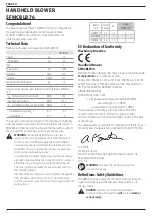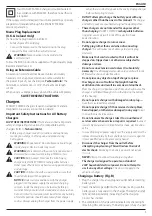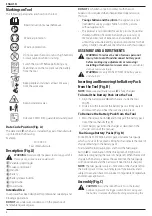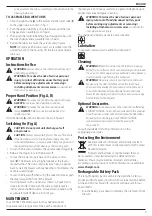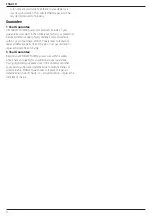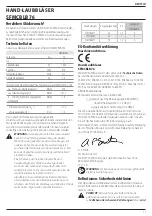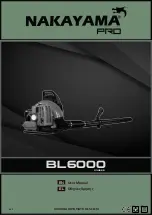
7
English
will stand upright on the battery pack but may be easily
knocked over.
Transportation
WARNING: Fire hazard.
Transporting batteries can
possibly cause fire if the battery terminals inadvertently
come in contact with conductive materials. When
transporting batteries, make sure that the battery
terminals are protected and well insulated from materials
that could contact them and cause a short circuit.
STANLEY FATMAX batteries comply with all applicable shipping
regulations as prescribed by industry and legal standards which
include UN Recommendations on the Transport of Dangerous
Goods; International Air Transport Association (IATA) Dangerous
Goods Regulations, International Maritime Dangerous Goods
(IMDG) Regulations, and the European Agreement Concerning
The International Carriage of Dangerous Goods by Road (ADR).
Lithium-ion cells and batteries have been tested to section 38.3
of the UN Recommendations on the Transport of Dangerous
Goods Manual of Tests and Criteria.
In most instances, shipping a STANLEY FATMAX battery pack
will be excepted from being classified as a fully regulated Class
9 Hazardous Material. In general, only shipments containing a
lithium-ion battery with an energy rating greater than 100 Watt
Hours (Wh) will require being shipped as fully regulated Class
9. All lithium-ion batteries have the Watt Hour rating marked
on the pack. Furthermore, due to regulation complexities,
STANLEY FATMAX does not recommend air shipping lithium-ion
battery packs alone regardless of Watt Hour rating. Shipments of
tools with batteries (combo kits) can be air shipped as excepted
if the Watt Hour rating of the battery pack is no greater than
100 Whr.
Regardless of whether a shipment is considered excepted
or fully regulated, it is the shipper's responsibility to consult
the latest regulations for packaging, labeling/marking and
documentation requirements.
The information provided in this section of the manual is
provided in good faith and believed to be accurate at the time
the document was created. However, no warranty, expressed or
implied, is given. It is the buyer’s responsibility to ensure that its
activities comply with the applicable regulations.
Storage Recommendations
1. The best storage place is one that is cool and dry away
from direct sunlight and excess heat or cold. For optimum
battery performance and life, store battery packs at room
temperature when not in use.
2. For long storage, it is recommended to store a fully charged
battery pack in a cool, dry place out of the charger for
optimal results.
nOTE:
Battery packs should not be stored completely depleted
of charge. The battery pack will need to be recharged before use.
Labels on Charger and Battery Pack
In addition to the pictographs used in this manual, the labels
on the charger and the battery pack may show the following
pictographs:
Read instruction manual before use.
See
Technical Data
for charging time.
Do not probe with conductive objects.
Do not charge damaged battery packs.
Do not expose to water.
Have defective cords replaced immediately.
Charge only between 4 ˚C and 40 ˚C.
Only for indoor use.
Discard the battery pack with due care for
the environment.
Charge STANLEY FATMAX battery packs only
with designated STANLEY FATMAX chargers.
Charging battery packs other than the
designated STANLEY FATMAX batteries with a
STANLEY FATMAX charger may make them burst or
lead to other dangerous situations.
Do not incinerate the battery pack.
Battery Type
The SFMCBLB76 operates on a 54 volt battery pack.
These battery packs may be used: SFMCB6025, SFMCB605,
SFMCB6075 Refer to
Technical Data
for more information.
Package Contents
The package contains:
1 Blower motor housing
1 Blower tube
1 Instruction manual
• Check for damage to the tool, parts or accessories which may
have occurred during transport.
• Take the time to thoroughly read and understand this manual
prior to operation.
Summary of Contents for FATMAX SFMCBLB76
Page 1: ...SFMCBLB76 www stanleytools eu ...
Page 3: ...1 Fig A Fig B Fig C 8 2 1 3 7 6 4 7 6 4 5 Fig D 3 9 ...
Page 115: ...113 ...




